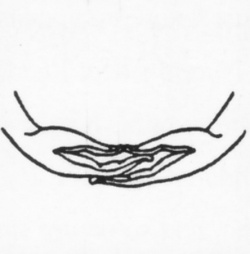Difference between revisions of "Dhyāna Mudrā"
(Created page with "thumb|250px| <poem> Meditation Gesture Sjoquist p. 33 Dhyāna Mudrā chándìng yìn 禅定印 禪定印 or dìng yìn 定印 This gestu...") |
|||
| Line 1: | Line 1: | ||
[[File:DhyanaMudra.JPG|thumb|250px|]] | [[File:DhyanaMudra.JPG|thumb|250px|]] | ||
<poem> | <poem> | ||
| − | Meditation Gesture | + | [[Meditation]] Gesture |
| − | Sjoquist p. 33 Dhyāna Mudrā | + | Sjoquist p. 33 [[Dhyāna]] Mudrā |
chándìng yìn 禅定印 禪定印 or dìng yìn 定印 | chándìng yìn 禅定印 禪定印 or dìng yìn 定印 | ||
| − | This gesture indicates | + | This gesture indicates [[Meditation]], or more exactly the highest state of tranquility ([[Samādhi]] or sānmótí 三摩提). Although long used in [[India]] as a position for the hands during [[Meditation]], in Buddhist [[Art]] this gesture is usually associated with [[Buddhas]], therefore usually Sakyamuni or Shìjiāmóuní fó 释迦牟尼佛 釋迦牟尼佛 and [[Amitābha]] or Ēmítuó fó 阿弥陀佛 阿彌陀佛. |
| − | (A begging bowl may be held atop the hands. When a medicine bowl is shown there, the figure is often Bhaiṣajyaguru, known in Chinese as simply Yàoshī fó 药师佛 药师佛 藥師佛, which means “Medicine Master Buddha,” associated with | + | (A begging bowl may be held atop the hands. When a medicine bowl is shown there, the figure is often Bhaiṣajyaguru, known in Chinese as simply Yàoshī fó 药师佛 药师佛 藥師佛, which means “Medicine Master [[Buddha]],” associated with [[Healing]]. Or it is Ēmítuó fó 阿弥陀佛 阿彌陀佛 (Amithābha), especially if both hands remain the [[Meditation]] Gesture position. In some cases only one hand is used in order to free up the other hand to perform a different mudrā.) |
</poem> | </poem> | ||
| + | |||
| + | [[Category:Buddhist Terms]] | ||
| + | |||
| + | [[Category:Meditation]] | ||
Revision as of 14:56, 27 March 2013
Meditation Gesture
Sjoquist p. 33 Dhyāna Mudrā
chándìng yìn 禅定印 禪定印 or dìng yìn 定印
This gesture indicates Meditation, or more exactly the highest state of tranquility (Samādhi or sānmótí 三摩提). Although long used in India as a position for the hands during Meditation, in Buddhist Art this gesture is usually associated with Buddhas, therefore usually Sakyamuni or Shìjiāmóuní fó 释迦牟尼佛 釋迦牟尼佛 and Amitābha or Ēmítuó fó 阿弥陀佛 阿彌陀佛.
(A begging bowl may be held atop the hands. When a medicine bowl is shown there, the figure is often Bhaiṣajyaguru, known in Chinese as simply Yàoshī fó 药师佛 药师佛 藥師佛, which means “Medicine Master Buddha,” associated with Healing. Or it is Ēmítuó fó 阿弥陀佛 阿彌陀佛 (Amithābha), especially if both hands remain the Meditation Gesture position. In some cases only one hand is used in order to free up the other hand to perform a different mudrā.)
